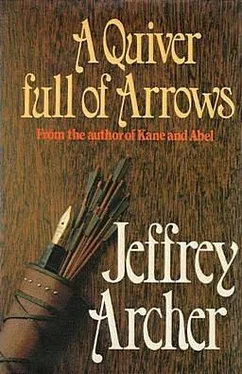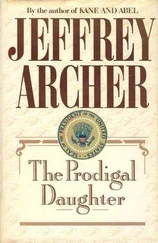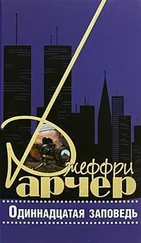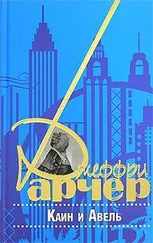They both ordered from the extensive menu and the langouste turned out to be excellent, every bit as good as Henry had promised of Maxim’s, but by then neither of them had the stomach to eat a full meal and the greater part of both their dishes was left on the plate.
Henry found it hard to convince the new headwaiter that the lobster had been superb and that they had purposely come to Maxim’s not to eat it. Over coffee, he took Victoria’s hand and tried to apologize.
“Let us end this farce,” he said, “by completing my plan and going to the Madeleine and presenting you with the promised flowers. Paulette will not be in the square to greet you but there will surely be someone who can sell us roses.”
Henry called for the bill and unfolded the third five-pound note (Maxim’s is always happy to accept other people’s currency and certainly didn’t bother him with any change) and they left, walking hand in hand toward the Madeleine. For once Henry turned out to be right, for Paulette was nowhere to be seen. An old lady with a shawl over her head and a wart on the side of her nose stood in her place on the corner of the square, surrounded by the most beautiful flowers.
Henry selected a dozen of the longest-stemmed red roses and then placed them in the arms of his bride. The old lady smiled at Victoria.
Victoria returned her smile.
“Dix francs, monsieur,” said the old lady to Henry.
Henry fumbled in his pocket, only to discover he had spent all his money. He looked despairingly at the old lady, who raised her hands, smiled at him and said:
“Don’t worry, Henry, have them on me. For old times’ sake.”
Sir Hamish Graham had many of the qualities and most of the failings that result from being born to a middle-class Scottish family. He was well educated, hard-working and honest, while at the same time being narrow-minded, uncompromising and proud. Never on any occasion had he allowed hard liquor to pass his lips, and he mistrusted all men who had not been born north of Hadrian’s Wall, and many of those who had.
After spending his formative years at Fettes School, to which he had won a minor scholarship, and at Edinburgh University, where he obtained a second-class honors degree in engineering, he was chosen from a field of twelve to be a trainee with the international construction company TarMac (named after its founder, J. L. McAdam, who discovered that tar when mixed with stones was the best constituent for making roads). The new trainee, through diligent work and uncompromising tactics, became the firm’s youngest and most disliked project manager. By the age of thirty Graham had been appointed deputy managing director of TarMac and was already beginning to realize that he could not hope to progress much farther while he was in someone else’s employ. He therefore began to think of forming his own company. When two years later the chairman of TarMac, Sir Alfred Hickman, offered Graham the opportunity to replace the retiring managing director, he resigned immediately. After all, if Sir Alfred felt he had the ability to run TarMac he must also be competent enough to start his own company.
The next day, young Hamish Graham made an appointment to see the local manager of the Bank of Scotland who was responsible for the TarMac account, and with whom he had dealt for the past ten years. Graham explained to the manager his plans for the future, submitting a full written proposal, and requesting that his overdraft facility be extended from fifty pounds to ten thousand. Three weeks later Graham learned that his application had been viewed favorably. He remained in his lodgings in Edinburgh, while renting an office in the north of the city (or, to be more accurate, a room at ten shillings a week). He purchased a typewriter, hired a secretary and ordered some unembossed headed letter-paper. After a further month of diligent interviewing, he employed two engineers, both graduates of Aberdeen University, and five out-of-work laborers from Glasgow.
During those first few weeks on his own Graham tendered for several small road contracts in the central lowlands of Scotland, the first seven of which he failed to secure. Preparing a tender is always time-consuming and often expensive, so by the end of his first six months in business Graham was beginning to wonder if his sudden departure from TarMac had not been foolhardy. For the first time in his life he experienced self-doubt, but that was soon removed by the Ayrshire County Council, who accepted his tender to construct a minor road which was to join a projected school with the main highway. The road was only five hundred yards in length, but the assignment took Graham’s little team seven months to complete and when all the bills had been paid and all expenses taken into account Graham Construction made a net loss of £143.10s.6d.
Still, in the profit column was a small reputation which had been invisibly earned, and caused the Ayrshire Council to invite him to build the school at the end of their new road. This contract made Graham Construction a profit of £420 and added still further to his reputation. From that moment Graham Construction went from strength to strength, and as early as his third year in business he was able to declare a small pre-tax profit, and this grew steadily over the next five years. When Graham Construction was floated on the London Stock Exchange the demand for the shares was oversubscribed ten times and the newly quoted company was soon considered a blue-chip institution, a considerable achievement for Graham to have pulled off in his own lifetime. But then the City likes men who grow slowly and can be relied on not to involve themselves in unnecessary risks.
In the sixties Graham Construction built motorways, hospitals, factories and even a power station, but the achievement the chairman took most pride in was Edinburgh’s newly completed art gallery, which was the only contract that showed a deficit in the annual general report. The invisible earnings column, however, recorded the award of knight bachelor for the chairman.
Sir Hamish decided that the time had come for Graham Construction to expand into new fields, and looked, as generations of Scots had before him, toward the natural market of the British Empire. He built in Australia and Canada with his own finances, and in India and Africa with a subsidy from the British government. In 1963 he was named “Businessman of the Year” by The Times and three years later “Chairman of the Year” by The Economist . Sir Hamish never once altered his methods to keep pace with the changing times, and if anything grew more stubborn in the belief that his ideas of doing business were correct whatever anyone else thought; and he had a long credit column to prove he was right.
In the early seventies, when the slump hit the construction business, Graham Construction suffered the same cut in budgets and lost contracts as any of its major competitors. Sir Hamish reacted in a predictable way, by tightening his belt and paring his estimates while at the same time refusing one jot to compromise his business principles. The company therefore grew leaner and many of his more enterprising young executives left Graham Construction for firms which still believed in taking on the occasional risky contract.
Only when the slope of the profits graph started taking on the look of a downhill slalom did Sir Hamish become worried. One night, while brooding over the company’s profit-and-loss account for the previous three years, and realizing that he was losing contracts even in his native Scotland, Sir Hamish reluctantly came to the conclusion that he must tender for less established work, and perhaps even consider the odd gamble.
His brightest young executive, David Heath, a stocky, middle-aged bachelor, whom he did not entirely trust — after all, the man had been educated south of the border and worse, at some extraordinary place in the United States called the Wharton Business School — wanted Sir Hamish to put a toe into Mexican waters. Mexico, as Heath was not slow to point out, had discovered vast reserves of oil off its eastern coast and had overnight become rich with American dollars. The construction business in Mexico was suddenly proving most lucrative and contracts were coming up for tender with figures as high as thirty to forty million dollars attached to them. Heath urged Sir Hamish to go after one such contract that had recently been announced in a full-page advertisement in The Economist . The Mexican government was issuing tender documents for a proposed ring road around its capital, Mexico City. In an article in the business section of The Observer , detailed arguments were put forward as to why established British companies should try to fulfill the ring road tender. Heath had offered shrewd advice on overseas contracts in the past that Sir Hamish had subsequently let slip through his fingers.
Читать дальше












